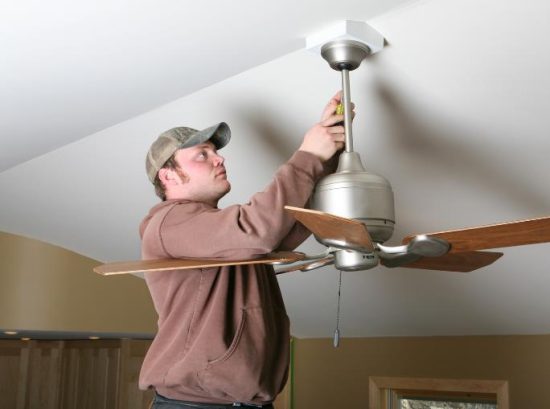When designing a bedroom, the comfort given by climate control options can significantly impact your overall pleasure with the space. A ceiling fan is necessary for many people among these choices because it offers an economical and energy-efficient means of maintaining comfort. What size ceiling fan for bedroom is crucial to making sure it fits the space and improves airflow without being too large.
Why Do We Need Ceiling Fan in Bedroom?

The purpose of a ceiling fan in the bedroom is to create a perfect, peaceful atmosphere and facilitate air circulation. When combined with other heating systems, a fan’s light breeze can circulate warm air during the colder months and help cool a space during the warmer ones. This dual purpose contributes to the year-round maintenance of a comfortable temperature, which might be necessary for restful sleep. Additionally, air conditioners use more energy than fan. So fan can lower utility costs. Moreover, having a ceiling fan might reduce the need for HVAC systems, saving even more power.
The relaxing sound of a fan may additionally serve as white noise, which many people find helpful in blotting out external noises and improving sleep quality. Fans may be adjusted to give the ideal airflow for comfort using various speed settings. In addition, contemporary ceiling fans have features like timers and remote controls, which increase convenience and let you alter the settings to suit your tastes. Finally, ceiling fans enhance the visual appeal of a space by providing an array of forms and patterns that can blend in with the décor of any bedroom.
How to Measure Fan in Bedroom?
When measuring for a ceiling fan, consider the size of your space and the ceiling height. Generally, you want the fan hanging at least seven feet above the ground to maximize airflow and ensure it is safely out of reach. If you have a room with a ceiling higher than eight feet, use a downrod to keep the placement correct.
The width of the fan should be appropriate for the room’s square footage. A simple rule of thumb is:
- For rooms up to 75 square feet, select a fan span of 28 to 37 inches.
- For rooms between 76 and 145 square feet, a fan size of 36 to 42 inches is ideal.
- For larger rooms up to 226 square feet, opt for a fan that measures 44 to 50 inches.
- For effective air circulation, rooms larger than 225 square feet might require a fan larger than 50 inches or two medium-sized fans.
What Size Ceiling Fan for Bedroom?
Measure the ideal ceiling fan size to ensure efficient and comfortable air circulation in your bedroom. When placed in a small room, a big fan may seem overwhelming and create unpleasant airflow. On the other hand, a little fan won’t do anything in an ample space because it won’t move enough air to be noticed. Ensuring the fan is the right size for your room will increase its efficiency and appearance.
Room Dimensions and Fan Size
Knowing how your room’s measurements relate to the correct fan size is essential. To find the square footage of your room, measure its length and width. With the help of this number, you can choose the ideal blade span for your ceiling fan to ensure it covers a sufficient area without taking up too much room. For example, a fan with a 30 to 48-inch blade spread is usually needed in a space that measures ten by 10 feet (100 square feet). Larger rooms, such as 15 × 15 feet (225 square feet), would benefit from a fan that spans 50 to 54 inches to circulate air adequately.
Ceiling Height and Downrod Length

The distance between blade of the fan and the floor must be considered for efficient air circulation. A more extended downrod may be needed in rooms with high ceilings to position the fan in the best possible way to move air effectively. On the other hand, a flush-mounted fan would help maximize available space and preserve safety clearances in areas with low ceilings. A flush mount or short downrod works well in a room with a conventional 8-foot ceiling, but a downrod of 12 to 18 inches may be necessary in a room with a 10-foot ceiling to bring the fan down to a more helpful level. For really tall areas, including those with 12-foot ceilings, a downrod between 24 and 36 inches can lower the fan to the ideal working height.
Blade Span and Airflow Efficiency
Appropriate blade span selection is necessary to guarantee effective airflow. A large fan may force too much air to circulate, which could be uncomfortable in smaller spaces. Conversely, in larger rooms, a too-tiny fan cannot circulate air efficiently. Complementing the blade span with the dimensions of the space improves energy efficiency and comfort. For instance, a fan with a 36 to 42-inch blade spread would be ideal for a 100-square-foot area since it would provide the best airflow without overpowering. On the other hand, a fan with a 50–56-inch blade span would be perfect for efficiently moving air across a 400-square-foot living area. This careful matching of blade size to room size avoids inefficient energy use and ensures all room areas receive adequate air movement.
Proportional Sizing for Aesthetic Harmony
It would be best to appreciate the ceiling fan’s aesthetic benefits. Instead of removing the overall beauty, a proportionate fan will improve your room. Think about how the fan will look in relation to the space’s windows, furnishings, and ceiling height. An enormous fan may balance the scale of spacious spaces and make a striking statement in a room with high ceilings and many windows. On the other hand, a modest fan between 30 and 44 inches can enhance the area without taking over in a smaller room with lower ceilings. Choosing a fan that harmonizes with the room’s dimensions and decor enhances functionality and style, making the ceiling fan an integral part of your room’s design.
Impact of Fan Size on Room Functionality
The fan’s size affects the room’s functionality, appearance, and ventilation. Appropriate fan sizing guarantees comfort without interfering with the use of the area. A huge fan can create a sense of constricted space in small offices or studies, and the excessive airflow might scatter papers. However, a fan that is too small won’t be able to circulate air in a bedroom adequately. Due to its inefficiency, more fans or cooling equipment could be needed, clogging the area and possibly raising energy expenses. A comfortable and functional space can be maintained by selecting the appropriate fan size. It stops disturbances brought on by improper airflow. Keeping the atmosphere in the space favorable to either relaxation or concentration, depending on its intended use, requires careful attention.
Conclusion
Selecting the appropriate size ceiling fan for your bedroom is essential to attain the intended level of efficiency and comfort. You may choose a fan that fits your space and meets your cooling demands by considering the room’s size and ceiling height. Remember that choosing the right size for your room is essential to maximize the effectiveness of your fan.
Related Articles:
FAQs on Choosing The Ceiling Fans For Bedroom
Can I fix a ceiling fan in a bedroom with a low ceiling?
Sure, rooms with low ceilings are meant for low-profile fans, also known as “hugger” fans. These models are positioned near the ceiling for security and sufficient ventilation.
How much energy could use a ceiling fan?
Ceiling fans are generally energy-efficient, using about the same energy as a standard light bulb. However, the exact usage varies depending on the model and settings.
Is it difficult to fix a ceiling fan?
The difficulty of installation depends. It’s a fairly simple do-it-yourself project, but if you don’t have any experience, it could be wise to hire an expert, particularly when working with electrical components.
How often should I clean my ceiling fan?
For best results, it is recommended that you clean your fan every two to three months. Dust accumulation may affect the fan’s balance and efficiency.

